- The Outpatient Costing and Classification Study was commissioned
by the Department of Health and Family Services to evaluate the
suitability of the Developmental Ambulatory Classification System
(DACS).
- Data on the full range of ambulatory services (outpatient clinics,
emergency departments and allied health services) were collected
prospectively from a stratified sample of 28 public hospitals.
Patient encounters captured in the study represent 1% of the total
ambulatory encounters in Australia in one year.
- Costing per encounter included time spent with the patient, cost of
procedures, indirect costs (salaries and consumables), overhead
costs and diagnostic costs.
- The most significant variable explaining cost variation was
hospital type, followed by outpatient clinic type. Visit type and
presence or absence of a procedure -- major splits for the proposed
DACS -- did not produce splits that were consistent across all
hospital strata.
- The study found that DACS is not an appropriate classification for
hospital ambulatory services.
- A clinic-based structure for outpatients and allied health departments is recommended for classifying and funding ambulatory services in Australia.
Introduction The Casemix Development Program which commenced in Australia in July 1988 focused on developing and implementing a national inpatient classification system for acute patients (AN-DRGs). Relatively little work was done on classifying and costing ambulatory services. In the early 1990s, however, two projects were conducted -- the National Ambulatory Casemix Project in Sydney1 and the Flinders Medical Centre Ambulatory Encounters Project in Adelaide,2 the latter in conjunction with the Royal Children's Hospital in Melbourne. These were primarily "demonstration" projects, which tested some overseas classifications and identified issues for future ambulatory classification projects.
In 1994, the National Ambulatory Care Reform Program focused attention on ambulatory services by funding studies to facilitate health policy development in this area.3 However, none of these projects addressed the need for a nationally consistent ambulatory classification system.
Recognising this, the Department of Health and Family Services requested that the Australian Casemix Clinical Committee establish a subcommittee to oversee the development of an ambulatory classification system for use in Australia. This committee reviewed existing classifications for their applicability in Australia,4 concluded that none were appropriate and recommended that a new classification system be developed to complement other patient-based classification systems.
This work resulted in the Developmental Ambulatory Classification System (DACS), which was patient-based and structured around Ambulatory Major Diagnostic Categories (AMDC), similar to the Major Diagnostic Categories of the AN-DRG classification. The major splits in the proposed classification were based on whether the patient was making a new or a repeat visit, and whether a significant procedure was performed (Box 1). A specially constructed expert panel identified which outpatient and emergency procedures were significant cost drivers. In contrast to the other major classification systems, this classification was not based on empirical data. DACS needed to be evaluated for its suitability as a national classification.
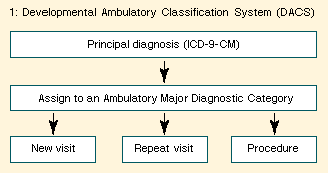
To address this issue an Outpatient Costing and Classification Study was commissioned by the Commonwealth Department of Health and Family Services in 1997.
Methods The Outpatient Costing and Classification Study was conducted in two phases.
Phase 1: Selecting and defining the data elements to be captured during the study and developing a sampling framework (conducted by Deloitte Touche Tohmatsu).5
Phase 2: Data capture and analysis of the results (conducted by Coopers & Lybrand and the South Australian Health Commission).6
The study aimed to include the full range of ambulatory services provided in public hospitals. For the purpose of the study, the term "ambulatory service" encompassed designated outpatient clinics (irrespective of location), emergency departments and allied health services for non-admitted patients. Because hospitals' recording of patient activity varies, the study also included same-day patients and inpatients treated within the outpatient and emergency departments.
Hospitals
Data were collected prospectively from a stratified sample of
Australian public hospitals. South Australian hospitals were
over-represented, because a similar State-based research project
was initiated in South Australia before the Commonwealth project.
Twenty-eight hospitals participated in the study. They included
eight teaching hospitals, two specialist hospitals, two
metropolitan hospitals, seven large rural hospitals and nine small
rural hospitals (Box 2).
Data collection
Senior staff from each hospital met with the consultants before study
commencement to ensure optimal data collection, and all hospitals
employed a project officer to facilitate on-site coordination. To
ensure data accuracy, a quality management plan was developed,
including tolerance reports and edit checks on the data.
Data collection commenced in September 1997 and continued in SA hospitals for three months, and at other sites for one month. Because of the difficulty in collecting detailed patient data in busy emergency departments, the collection period in emergency departments was four weeks in South Australia and two weeks in other States.
Detailed utilisation data were obtained for each patient in the study (Box 3).
A patient encounter was defined as "an interchange between one or more healthcare providers and one or more patients, for assessment, consultation and/or treatment for intended unbroken period of time".
Telehealth consultations (including videoconferencing, telemedicine and telephone contacts) were included if the clinician who had previously seen the patient was present, and when the service was considered to be a substitute for face-to-face contact.
Radiology and pathology services and dispensed pharmaceuticals were not considered encounters in their own right, but were subsequently linked to the "primary" encounter (ie, the encounter in which the services were ordered).
Reviewing results, dictating letters and making telephone calls, which are generally consistent across all encounters, were included as indirect costs (although some clinicians elected to record the time associated with these activities as direct patient contact time).
Telephone calls were recorded if the clinician who had previously seen the patient was present and when the service was considered to be a substitute for face-to-face contact.
Indirect encounters related to consultations with key providers and relatives of patients in which the patient was the focus of the encounter.
Group encounters were defined as encounters with more than one patient and/or more than one practising clinician present.
All hospital-paid staff who were involved in providing patient care were requested to record the amount of time they spent in direct patient contact. This has been previously reported as the most variable aspect of an outpatient encounter.1 Specific proformas were developed to collect details on nursing time, medical time, allied health time, diagnostic services (pathology and imaging) and therapeutic services (pharmaceuticals).
Coding
Accurate diagnosis and procedure coding are not routinely collected
for ambulatory patients in Australia. ICD-9-CM classification to
the three-digit level was adopted as the minimum standard for coding
during the project. This did not reduce the specificity of the
clinical data, with some 4364 different codes being used across the
study. Coding to the fourth and fifth digit was permissible if desired
by clinicians.
Standardising the clinic profile
A set of generic outpatient clinics had to be established to
standardise the profile of outpatient clinics within Australian
hospitals. The use of outpatient clinics as a classification
variable had been supported by several ambulatory studies,
including the Victorian Ambulatory Classification
System,7
the Queensland Health Ambulatory
Project,8 and the Flinders Medical
Centre Ambulatory Encounters Project.2 From these sources a list of
76 generic clinics was identified.
Data collection sites were requested to map their clinics to this list. Some hospitals had difficulty in mapping their very specialised clinics. In these situations additional clinic names were added. With these refinements a final generic clinic list comprising 78 clinics was obtained.
Costing data
Patient level cost data were used to determine the cost of each
encounter in four steps:
Direct costs: The cost of direct time spent with a patient and the cost of significant procedures for individual encounters were allocated to the specific encounter.
Indirect costs: Salary costs and costs for consumables (derived by deducting direct cost from total expenditure reported in line items in ambulatory cost centres) were dispersed across all ambulatory encounters.
Overhead costs: Overhead costs, determined by an approach similar to that employed in COSMOS,9 were dispersed across all ambulatory encounters. This process allows all costs incurred in providing services -- power, cleaning and infrastructure costs as well as direct costs -- to be allocated to an individual encounter.
Diagnostic costs: Patient specific utilisation data relating to radiology, pathology and pharmacy were downloaded from hospitals' information systems. Standardised unit prices were adopted for radiology and pathology services. This was set at 85% of the Medical Benefits Schedule (MBS) fee. Pharmacy costs were directly allocated and included Section 100 drugs. These costs were directly allocated to the primary ambulatory encounter.
Most hospitals in the study were able to provide detailed costing information, with the exceptions being some of the small hospitals in South Australia. To estimate outpatient cost in these hospitals, a proxy outpatient fraction was derived from information obtained during the National Hospital Cost Data Collection Study.
Statistical analyses
Statistical analysis of the data measured the significance of the
associations between the independent variables and the dependent
variable, which in this case was cost.
Results The study collected clinical and demographic data on 248 608 patient encounters (Box 4). Additional data were incorporated into the database: two previous emergency department studies (the Flinders Medical Centre Emergency Department Study10, and the Women's and Children's Emergency Department Study11); the Mental Health Classification and Service Costing Project (MH-CASC) relating to ambulatory encounters in the Mental Health Division of the Women's and Children's Hospital;12 and data from Launceston and Burnie Hospitals in Tasmania.
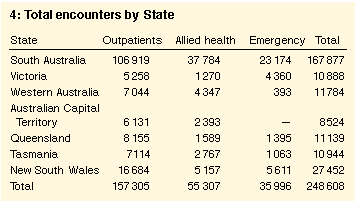
The patient encounters captured in the study represent about 1% of the total hospital ambulatory encounters in Australia each year.10 Over 82% of these encounters were referred from three sources: other services within the hospital (33%); community general practitioners (28%) and self-referral (22%). The high proportion of self-referred patients was due to the inclusion of emergency department data. Thirty-four per cent of all encounters were new visits. The average cost of a new visit was $128, and of a repeat visit, $110.
There were 10% more female than male patient encounters in the study population, and the number of public patient encounters greatly exceeded other types (86.6% of patients were public, 7.6% private, and 5.7% Department of Veterans' Affairs).
Of the patient encounters analysed, 95% were direct encounters, 3.5% were telephone encounters and 1.5% were indirect contacts. The average cost for these encounters was $116 (direct), $129 (indirect), $115 (telephone) and $152 (telemedicine), respectively.
There were only 46 telemedicine encounters captured during the study period. This represented 0.02% of total encounters.
The costs of providing services to patients in hospital outpatient departments and in the ambulatory service components of hospital allied health departments are given in Box 5. This clinic structure was standardised for all hospitals.
Group encounters were partitioned on the basis of hospital type and clinic type in the same manner as one-to-one encounters to facilitate standardised approaches to data collection and reporting. After trimming data to remove outliers, 0.5% of clinic encounters were group encounters. The average per patient cost of a "group encounter" was $82. This was about $20 less than one-to-one encounters. A list of group encounters and costs is given in Box 6.
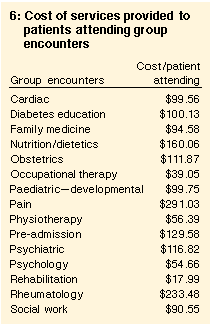
Emergency department analysis incorporating data from two previous studies (as mentioned above), and other studies conducted in Australia, have identified the key resource drivers in an emergency department as being triage, disposition and age.1
Classification analysis The objective was to design, from first principles, an outpatient classification system which could be used to fund ambulatory activity, and in doing so report on the appropriateness of the DACS as a framework for a patient-based classification system.
A total of 198 495 episodes were analysed in detail, after removal of incomplete episodes. For selected components, data were trimmed to exclude cost outliers (defined as < 4 or > 5 SD from the mean); 1008 records were excluded on this basis. Analysis of emergency department data was conducted separately.
The most significant variables identified were hospital type (teaching, specialist, metropolitan, large rural and small rural), outpatient clinic type, visit type (new or repeat), age and significant procedure. The impact of hospital type was highly significant and became the principal variable producing splits. An analysis of secondary variables producing splits is given in Box 7.
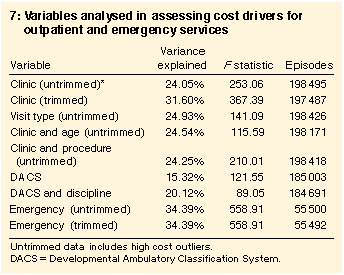
Clinic-based classification
Clinic type explained 24.05% of the cost variation in untrimmed data,
and 31.60% of the cost variation in trimmed data. The variation
explained was less significant for teaching hospitals (18.04% for
untrimmed data and 23.93% for trimmed data). The variation in
teaching hospital costs may have been a consequence of the higher
number of junior staff who may have ordered additional diagnostic
tests and the variable profile of clinicians attending the same
patient.
A detailed review was conducted of the variables associated at the next level of the classification tree, testing, in particular, age, visit type and the presence or absence of a significant procedure. This analysis did not produce splits which were consistent across all hospital strata. These factors were not considered to be significant splitting variables.
To complete the classification analysis, it was necessary to examine group encounters and telephone contacts. Difficulty in defining telephone calls for funding purposes has resulted in telephone calls being excluded in many casemix-funding models. As the cost differential between face-to-face contacts and telephone contacts is so small, a case could be made for recommending funding these services in the same manner as face-to-face contacts. However, concerns were raised about the gaming potential for this class of encounters.
Emergency department system
When analysing emergency department episodes on the basis of urgency
(as assessed by the National Triage Scale) and disposition, a
significant explanation of variance was obtained. This remained at
34.39% for both trimmed and untrimmed data. Box 8 details the
proportion and cost of encounters, by triage, disposition and age.
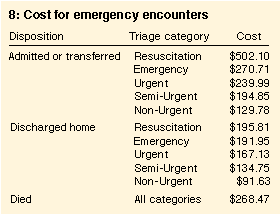
The performance of this classification structure in small rural hospitals was extremely poor and produced a 0.93% reduction in variance. The flat average cost across the range of classes within this hospital stratum suggests that these services should be funded at a standard rate.
DACS structure
The assignment to DACS classes was based on the principal diagnosis
coded, using ICD-9-CM codes. Problems occurred in the assignment of
patients to DACS classes because there was no unique mapping of ICD-9
CM codes to AMDCs. For example "fracture of facial bones" could be
assigned to AMDC 2, 3 or 8 (Eye; Ear, Nose, Mouth and Throat; and
Musculoskeletal System and Connective Tissue, respectively). This
was not addressed during the design phase of the project, and to
resolve this an additional step was incorporated into the grouping
process. This step used "clinic type" as a defining variable. This
allowed 80% of all encounters to be assigned to a specific DACS class.
It is not possible to determine whether the 20% of episodes excluded
from the analysis had a significant impact on the result.
The DACS explained only 15.32% of cost variation when stratified by hospital type. The performance of this classification system was marginally improved when a secondary split based on professional discipline (allied health, emergency, outpatient) was included (20.12%).
Discussion It is imperative to establish a standard classification system for ambulatory patients, as has been done for acute patients. Healthcare funders and providers need to able to describe the ambulatory patient profile.
Previous studies attempting to explain the resource variation for ambulatory patients have found that classifications based on the provider, rather than the patient, explain greater variation in patient costs. This is to be expected, as ambulatory care takes place in a relatively constrained environment. Clinicians designate "time slots" for their patients based on criteria relevant to their specialty areas. Patients may also be seen for the same condition by medical specialists and by allied health professionals -- the characteristics of the patient are unchanged, but the treatment regimens and resource use by the provider can vary greatly.
Nevertheless, despite the difficulties entailed in development, a patient-based classification is considered the ideal long term classification structure for ambulatory encounters, as it would truly reflect the clinical condition of patients and thus enhance the clinical utility of such a system. The DACS, developed with input from experienced clinicians, was designed with this intent but, before this type of classification can be introduced, hospital outpatient information systems will have to be greatly enhanced. A complex patient-based classification requires the collection of patient activity and clinical data, which would exceed the capacity of existing manual or electronic systems.
The study clearly indicates that the proposed DACS, in its current form, is not appropriate for classifying hospital based ambulatory services, and that in future classification development work the AMDC structure should not be considered an appropriate primary classification variable.
More importantly the study identifies the generic clinic classification structure, partitioned by hospital type, as the most appropriate classification system for one-to-one encounters in outpatient clinics and allied health departments. Group encounters should also be classified by generic clinic type. Separate cost weights would apply to one-to-one and group encounters.
The classification of emergency department presentations has been the subject of extensive research. This project confirms previous reports that triage category and patient disposition should be used to classify one-to-one encounters in emergency departments.9
In the short term, the generic clinic based structure for outpatients and allied health departments and the urgency and disposition based structure for emergency departments are recommended for classifying and funding ambulatory services in Australia.
Acknowledgements This study was funded by the Commonwealth Department of Health and Family Services and sponsored by the Australian Casemix Clinical Committee, receiving constant support from all members and its then Chair, Professor John Hickie. We would like to acknowledge the cooperation of staff at the study hospitals. The burden placed on hospital staff in collecting detailed information on individual outpatient encounters cannot be underestimated and the commitment to "see the project through" was a major undertaking. We also acknowledge the assistance of State and Territory health departments, Malcolm Bond from Flinders University, Dr Chris Baggoley from Flinders Medical Centre and Coopers & Lybrand Consultants.
This article is based on the Outpatient Costing and Classification
Study undertaken by Coopers & Lybrand on behalf of the South
Australian Health Commission and the Commonwealth Department of
Health and Family Services, April, 1998.
References
- Hindle D, Ligaida R. A casemix classification for hospital-based ambulatory services: a report from the National Ambulatory Casemix Project, New South Wales Department of Health. Sydney: New South Wales Department of Health, 1992.
- Michael R, Piper K, Heard P. Ambulatory Encounters Project, Flinders Medical Centre, Adelaide. Report for the Commonwealth Department of Health and Family Services, 1991 (available from the Department).
- Medicare agreement 1993-1998. Canberra: Commonwealth Department of Health and Family Services, 1993.
- Commonwealth Department of Health and Family Services, Classification and Payments Branch. Ambulatory casemix in Australia: Description of relevant classification systems. Canberra: Commonwealth Department of Health and Family Services, October 1995.
- Deloitte Touche Tohmatsu. DACS Pilot Study Progress Report. Report for the Commonwealth Department of Health and Family Services, Canberra. Sydney: Deloitte Touche Tohmatsu, 1997.
- Coopers & Lybrand Consultants. Outpatient Costing and Classification Study incorporating the Developmental Ambulatory Classification System Evaluation. Report for the Commonwealth Department of Health and Family Services, Canberra. Adelaide: Coopers & Lybrand Consultants, 1998.
- Jackson T, Sevil P, Tate R, Collard K. Development of relative resource weights for non-admitted patients. Melbourne: National Centre for Health Program Evaluation, 1989.
- Coopers & Lybrand Consultants. Queensland Health Ambulatory Project. Brisbane: Coopers & Lybrand Consultants, 1996.
- COSMOS [computer program], Version 2.0. Sydney: NSW Health.
- Erwich-Nijhout MA, Bond MJ, Baggoley C. Costings in the Emergency Department, Flinders Medical Centre, Adelaide. Report for the Commonwealth Department of Health and Family Services, 1996 (available from the Department).
- Erwich-Nijhout MA, Bond MJ, Raftos J. Costings in the Paediatric Emergency Department, Women's and Children's Hospital, Adelaide. Report for the Commonwealth Department of Health and Family Services, 1996 (available from the Department).
- Mental Health Classification and Service Costs Project. Developing a casemix classification for mental health services. Final report: Volumes 1 and 2. Canberra: Commonwealth Department of Health and Family Services, Aug 1998.
Authors' details Princess Alexandra Hospital, Brisbane, QLD.
Michael I Cleary, FACEM, MHA, Executive Director of Medical Services.
Department of Health and Family Services, Canberra, ACT.
Jo M Murray, BSc(Med), Acting Assistant Secretary,
Classification and Payments Branch.
Deloitte Touche Tohmatsu Consulting Group, Sydney, NSW.
Robin Michael, BSc(Hons), MPH, Partner.
South Australian Department of Human Services, Adelaide, SA.
Kym Piper, MNIA, Principal Consultant, Health Costing and
Evaluation Unit.
Reprints will not be available from the authors.
Correspondence: Dr M
I Cleary, Executive Director of Medical Services, Princess
Alexandra Hospital, Woolloongabba, QLD 4102.
E-mail: clearymAThealth.qld.gov.au




